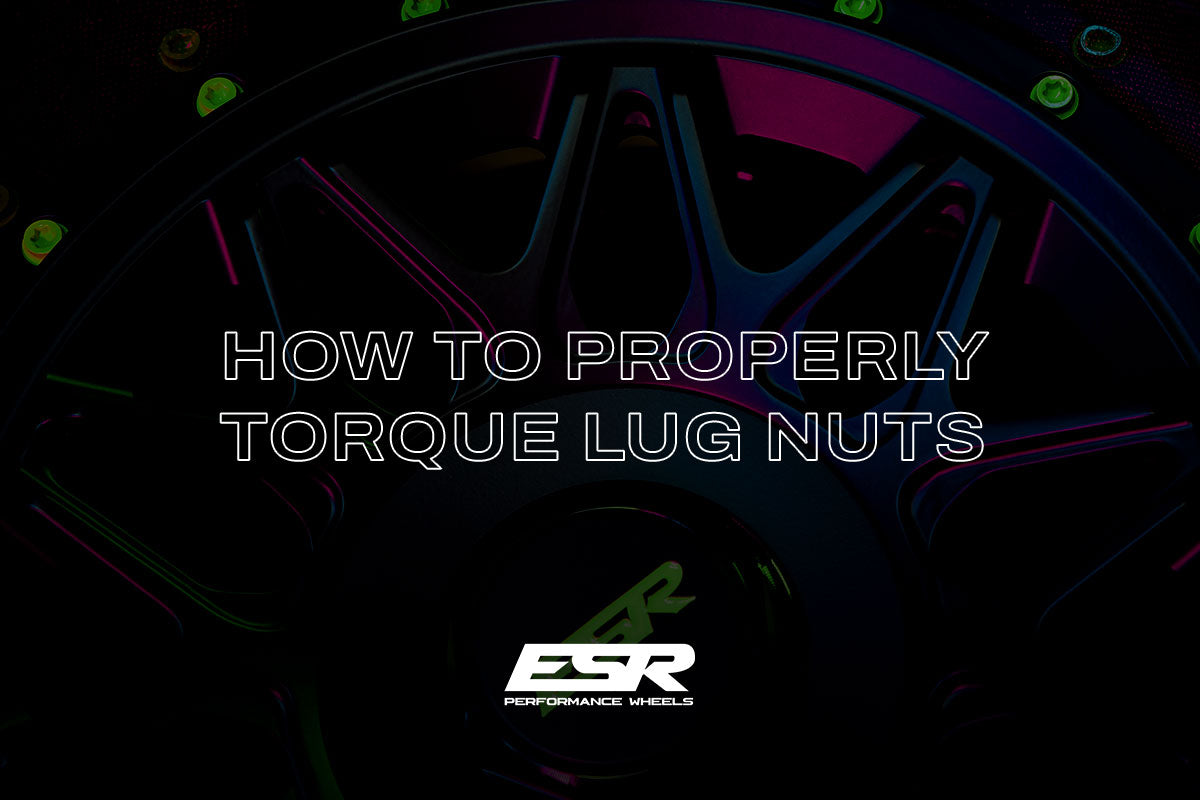
How To Properly Torque Lug Nuts
Properly torquing lug nuts is a crucial aspect of vehicle maintenance that ensures your wheels are securely attached, promoting safety and optimal performance. Incorrectly torqued lug nuts can lead to serious issues, such as wheel detachment or warped brake rotors, which compromise both safety and vehicle handling. Whether you're installing new aftermarket wheels from ESR Wheels or simply rotating your tires, knowing the correct procedure for torquing lug nuts is essential. In this blog, we’ll guide you through the steps and best practices to properly torque lug nuts, ensuring your wheels are firmly and safely in place.
What Are Lug Nuts?
Lug nuts are the fasteners used to secure a vehicle's wheels to its axles. They play a critical role in ensuring the wheels remain firmly attached to the vehicle, maintaining stability and safety during driving. Typically made from high-strength steel or aluminum, lug nuts are designed to withstand significant stress and torque. There are various types of lug nuts, including conical seat, ball seat, flat seat, and spline drive, each suited for different wheel designs and applications. Understanding the type and purpose of lug nuts is essential for proper installation and maintenance, especially when upgrading to aftermarket wheels like those offered by ESR Wheels.
Tools Needed for Torquing Lug Nuts
Properly torquing lug nuts requires a few essential tools to ensure accuracy and safety. First, a torque wrench is indispensable for applying the correct amount of force, preventing both under-tightening and over-tightening. A socket set is necessary to match the size of your lug nuts, ensuring a secure fit during the torquing process. Additionally, a jack and jack stands are crucial for lifting and stabilizing your vehicle, providing safe and easy access to the wheels. If your vehicle has locking lug nuts, a lug nut key is required to remove and reinstall them. Using these tools properly will ensure your wheels are securely fastened, enhancing safety and performance.
Steps to Properly Torque Lug Nuts
-
Prepare the Vehicle:
- Park on a flat surface.
- Engage the parking brake.
- Lift the car using a jack and secure it with jack stands.
- Remove current lug nuts and wheels.
-
Initial Hand Tightening:
- Reinstall the wheel and-tighten the lug nuts to seat them properly.
-
Set the Torque Wrench:
- Adjust your torque wrench to your vehicle's recommended torque specification.
-
Tighten in a Crisscross Pattern:
- Using the torque wrench, tighten each lug nut in a crisscross pattern to ensure even pressure distribution and prevent warping.
-
Double-Check Torque:
- Recheck each lug nut with the torque wrench to confirm they are all tightened to the correct specification.
Torque Specifications
Finding the right torque specification for your vehicle's lug nuts is crucial for maintaining safety and preventing damage. Consult your vehicle's owner manual or manufacturer's specifications to determine the exact torque value required. Adhering to these recommendations ensures that the lug nuts are tightened to the appropriate level, preventing under-tightening that could lead to loosening while driving or over-tightening that could damage the threads or warp brake components. Using a torque wrench set to the correct specification helps maintain wheel integrity and ensures consistent performance and safety while driving. Always refer to the manufacturer's guidelines to ensure proper torque application for your specific vehicle model.
Common Mistakes to Avoid
Avoiding these common mistakes is crucial for ensuring proper torque application and maintaining safety:
- Over-Tightening: Applying excessive force can result in damaged threads or warped brake rotors. It's essential to use a torque wrench to apply torque evenly and within recommended limits to prevent such issues.
- Under-Tightening: Insufficient torque can lead to loose lug nuts, posing risks such as vibrations or even wheel detachment while driving. Using a torque wrench ensures accurate tightening to recommended specifications, enhancing overall safety.
- Using the Wrong Tools: Incorrect tools may fail to secure lug nuts properly, leading to improper torque application. Always use the correct socket size and ensure tools fit securely to avoid slippage or potential damage during maintenance tasks.
By avoiding these pitfalls and adhering to proper torque procedures with appropriate tools, drivers can effectively enhance vehicle safety and durability, promoting smoother and safer travels.
Importance of Re-Torquing Lug Nuts
Regularly re-torquing lug nuts is fundamental to upholding both vehicle safety and performance:
- When and Why to Re-Torque: It is critical to re-torque lug nuts following initial installation, tire rotations, or any wheel removal to mitigate the risk of loosening caused by settling or temperature shifts.
- Steps for Re-Torquing: Begin with cooled wheels and employ a torque wrench to systematically tighten lug nuts in the prescribed sequence. Verify the torque of each lug nut against manufacturer specifications to maintain optimal tightness. This regimen significantly bolsters driving safety by preventing issues like wheel vibration, uneven tire wear, and the potential for wheel detachment.
By diligently following these re-torquing practices, drivers can enhance their vehicle's stability and longevity, ensuring safer journeys and minimizing maintenance challenges over time.
Safety Tips
Ensuring vehicle stability and longevity is paramount with these essential tips:
- Ensuring Vehicle Stability: Safely elevate your vehicle using jack stands on level ground to prevent accidents during maintenance tasks. This practice ensures stability and prevents the vehicle from slipping or tipping.
- Regular Maintenance and Checks: Routinely examine lug nuts, tires, and brakes to confirm they meet torque specifications and are free from wear or damage. Adhering to manufacturer-recommended maintenance intervals guarantees optimal vehicle safety and performance over time.
By implementing these practices, you not only enhance the stability and safety of your vehicle but also extend its lifespan, ensuring reliable performance on the road. Regular inspections and proper maintenance are key to preventing potential issues and maintaining your vehicle's peak condition.
Conclusion
In conclusion, properly torquing lug nuts is not just about tightening bolts—it's about ensuring safety and performance on the road. By following the correct procedures with the right tools, you can prevent issues like loose wheels or damaged components. Whether you're installing new aftermarket wheels from ESR Wheels or performing routine maintenance, adhering to manufacturer torque specifications is crucial. Regularly re-torquing lug nuts and conducting routine inspections will help maintain your vehicle's stability and safety over time. Remember, safety starts with proper maintenance, so prioritize precision and care when handling your vehicle's lug nuts.

